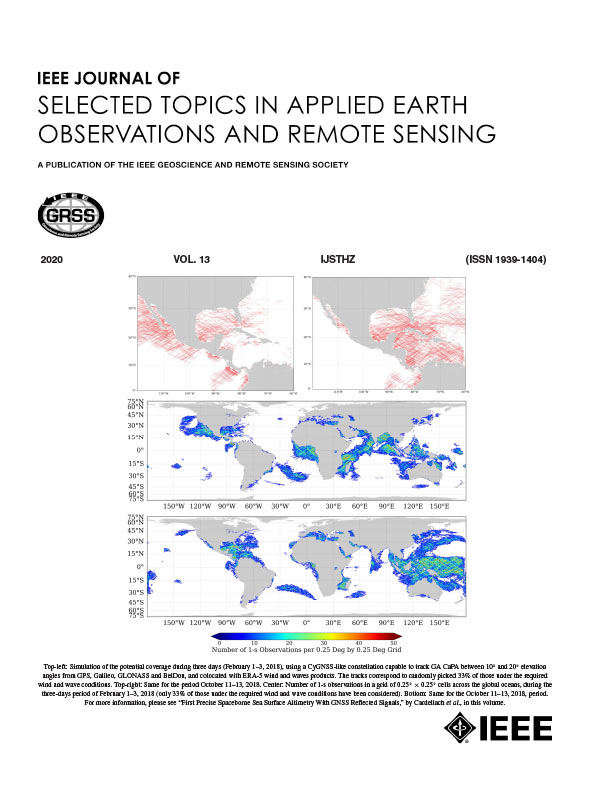UMTF-Net: An Unsupervised Multiscale Transformer Fusion Network for Hyperspectral and Multispectral Image Fusion
IF 4.7
2区 地球科学
Q1 ENGINEERING, ELECTRICAL & ELECTRONIC
IEEE Journal of Selected Topics in Applied Earth Observations and Remote Sensing
Pub Date : 2024-09-16
DOI:10.1109/JSTARS.2024.3461152
引用次数: 0
Abstract
Hyperspectral images (HSIs) are extensively utilized in several fields due to their abundant spectral band, particularly for tasks like ground object classification and environmental monitoring. However, as a result of equipment and imaging condition constraints, HSI frequently demonstrates a restricted spatial resolution. The fusion of a low-resolution HSI and a high-resolution multispectral image (HR-MSI) of the same scene is a crucial method for generating an HR-HSI. At present, due to factors, such as complexity and GPU memory limitation, most of the HSI–MSI fusion algorithms based on deep learning (DL) cannot utilize the transformer module well to capture the long-range dependence information in large-size remote sensing images. At the same time, the lack of a large amount of high-quality training data has become an important problem that affects the performance of fusion algorithms based on DL. In response to the above issues, this article introduces a new unsupervised multiscale transformer fusion (UMTF) network, called UMTF-Net, which enables HSI–MSI fusion without the need for additional training data. UMTF-Net is composed of an HSI fusion network and a U-network (U-Net)-based multiscale feature extraction network. In order to learn the cross-feature spatial similarity and long-range dependency of MSI and HSI, we first extract the multiscale features of MSI using the U-Net-based multiscale feature extraction network. We then input these features into the corresponding scale cross-feature fusion transformer module in the HSI fusion network to conduct feature fusion. Then, we input the fused features into the spatial spectral fuse attention module for spatial spectral feature enhancement, and finally generate HR-HSI. Comparing UMTF-Net to other advanced methods, the fusion results from three datasets and multiple ablation experiments indicate that our method performs excellently in different evaluations.UMTF-Net:用于高光谱和多光谱图像融合的无监督多尺度变换器融合网络
高光谱图像(HSI)因其丰富的光谱波段而被广泛应用于多个领域,特别是在地面物体分类和环境监测等任务中。然而,由于设备和成像条件的限制,高光谱图像的空间分辨率往往有限。融合同一场景的低分辨率 HSI 和高分辨率多光谱图像(HR-MSI)是生成 HR-HSI 的重要方法。目前,由于复杂性和 GPU 内存限制等因素,大多数基于深度学习(DL)的 HSI-MSI 融合算法不能很好地利用变换模块捕捉大尺寸遥感图像中的长距离依赖信息。同时,缺乏大量高质量的训练数据也成为影响基于 DL 的融合算法性能的重要问题。针对上述问题,本文介绍了一种新的无监督多尺度变换器融合(UMTF)网络,即 UMTF-Net,它无需额外的训练数据就能实现 HSI-MSI 融合。UMTF-Net 由人机交互融合网络和基于 U 网络(U-Net)的多尺度特征提取网络组成。为了学习 MSI 和 HSI 的交叉特征空间相似性和长程依赖性,我们首先使用基于 U-Net 的多尺度特征提取网络提取 MSI 的多尺度特征。然后,我们将这些特征输入 HSI 融合网络中相应尺度的交叉特征融合转换模块,进行特征融合。然后,我们将融合后的特征输入空间光谱融合注意模块,进行空间光谱特征增强,最后生成 HR-HSI。将 UMTF-Net 与其他先进方法进行比较,三个数据集和多次消融实验的融合结果表明,我们的方法在不同的评估中表现出色。
本文章由计算机程序翻译,如有差异,请以英文原文为准。
求助全文
约1分钟内获得全文
求助全文
来源期刊
CiteScore
9.30
自引率
10.90%
发文量
563
审稿时长
4.7 months
期刊介绍:
The IEEE Journal of Selected Topics in Applied Earth Observations and Remote Sensing addresses the growing field of applications in Earth observations and remote sensing, and also provides a venue for the rapidly expanding special issues that are being sponsored by the IEEE Geosciences and Remote Sensing Society. The journal draws upon the experience of the highly successful “IEEE Transactions on Geoscience and Remote Sensing” and provide a complementary medium for the wide range of topics in applied earth observations. The ‘Applications’ areas encompasses the societal benefit areas of the Global Earth Observations Systems of Systems (GEOSS) program. Through deliberations over two years, ministers from 50 countries agreed to identify nine areas where Earth observation could positively impact the quality of life and health of their respective countries. Some of these are areas not traditionally addressed in the IEEE context. These include biodiversity, health and climate. Yet it is the skill sets of IEEE members, in areas such as observations, communications, computers, signal processing, standards and ocean engineering, that form the technical underpinnings of GEOSS. Thus, the Journal attracts a broad range of interests that serves both present members in new ways and expands the IEEE visibility into new areas.

 求助内容:
求助内容: 应助结果提醒方式:
应助结果提醒方式:


